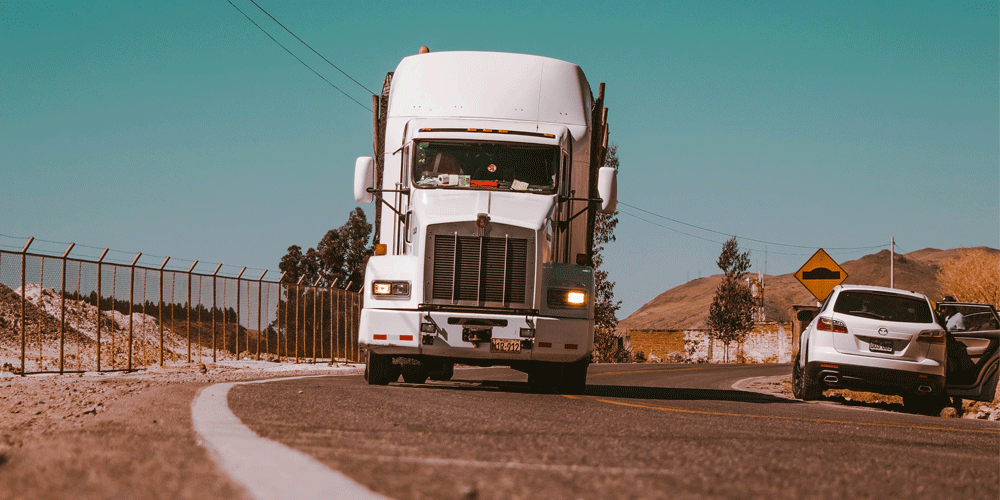Semi-Truck Collision Avoidance Systems: How They Work and Prevent Accidents
David spent more than a decade truck driving. He now serves as a safety manager at ATS making sure drivers like you have all the tools you need to succeed on the road.
Are you looking for a way to limit collisions on the road? Collision avoidance systems may be a great way to do it. According to the Insurance Institute for Highway Safety (IIHS), collision mitigation systems can prevent as many as two in five crashes,
Most — if not all — newer truck models in the industry have some type of collision mitigation. In fact, since 2017, the National Highway Traffic Safety Administration (NHTSA) has required new trucks to be equipped with electronic stability control (ESC). These systems work to reduce rollovers and loss of control by utilizing computer-controlled braking. The goal is to significantly reduce untripped rollovers and loss-of-control crashes.
However, some trucking companies still don’t invest in other forms of collision prevention, like automatic emergency braking (AEB) systems. Some drivers don’t like the equipment either, thinking it’s a way to spy on them or control their driving. When you understand how the new technology works, however, you can work with it, not against it.
At Anderson Trucking Service (ATS), we make safety one of our top priorities. That means we utilize technology like speed limiters, front-facing cameras and collision mitigation equipment to help keep our drivers safer on the road.
It’s our job to not only keep our drivers safe but to also keep the motoring public safe. When we keep drivers safe, we’re more likely to deliver freight in a timely, safe manner, decrease liability and reduce overall maintenance costs.
In this article, you’ll learn:
- How collision avoidance systems work
- Types of collision avoidance technology
- Why collision avoidance systems are necessary
- How to work with collision avoidance technology, not against it
What is a Collision Avoidance System?
Collision avoidance systems, also called crash mitigation or accident mitigation equipment, utilizes various technologies to help drivers decrease risks and avoid collisions. Technology and sensors utilized include lasers, radar, cameras, GPS and artificial intelligence (AI). AI sensors use contextual data to understand how the driver is going to react to make real-time decisions about risks.
Often, there’s radar built into the front bumper and a camera built into the windshield. Sensors may be placed around the truck depending on what type of crash mitigation technology you have. Older technology didn’t have a camera built into the windshield, so some false events would occur; this was a source of frustration for drivers.
The radar on the front bumper senses metal objects. It sends out a radar signal that bounces off metal objects in front of it. It works together with the camera to provide the relative distance and speed of the object ahead. The camera, by searching for a license plate, verifies that the object is a vehicle. This is called object recognition capability.

Types of Collision Avoidance Systems and Alerts
There are several different systems that companies can utilize in their semi-trucks. Some systems can sense speed ahead, some can slow the truck's speed by utilizing braking systems and some can sense lane departure.
We mentioned ESC and AEB earlier, but there’s also adaptive cruise control. These collision avoidance assist systems will actually take control of the vehicle to help you avoid a collision.
With adaptive cruise control, your truck will maintain the proper following distance. If the vehicle in front of you slows, the system will apply your brakes to slow the truck until you reestablish the correct following distance. Your truck will speed up to maintain the correct distance if there becomes too large of a gap.
Collision avoidance alert systems include forward collision warning, cross traffic warning, pedestrian detection, lane departure warning and blind-spot warning. These systems only provide alerts; they don’t control your system for you.
Cross-traffic warning systems, pedestrian detection and blind spot warning alert you when a vehicle or pedestrian is in your path. Lane departure warning will alert you when you veer out of your lane.
When all of these systems work together, they can alert you of an incoming hazard and even slow your vehicle for you. For instance, forward collision technology can alert you when you’re quickly approaching and about to hit a moving or stationary vehicle. It only alerts you; it won’t brake for you. However, your AEB system can brake for you.
Why Collision Mitigation Technology is Essential
Collision mitigation technology has the potential to reduce collisions, prevent injuries and save lives. While plenty of private vehicles use these systems, many experts believe that too few commercial trucks have implemented them.
Because drivers spend almost all of their time on the road, they’re prone to fatigue. Inattentiveness isn’t uncommon after hours spent on the road. This technology provides another level of protection for drivers. It in no way, shape, or form replaces the driver or their responsibility to actively manage your driving, but it can provide much-needed assistance.
Working with Collision Mitigation Technology, Not Against It
It takes a skilled driver to avoid any sort of collision for the entirety of time as a driver. When you work with accident mitigation equipment, however, you increase your chances of staying accident-free.
To work with the equipment, rather than against it, your first step is to be safety-minded. You should never fully rely on the technology; it’s just a tool designed to help you.
Limit distractions wherever possible — whether that be physical, cognitive or visual distractions. Mind your following distance and drive at safe speeds. That way, if something does happen in front of you, you have ample time to slow down.
Pay attention to alerts. Depending on your system, they may show up on your dashboard or on your side view mirrors. Don’t ignore alerts. Reduce your speed.
It’s important to remember the technology doesn’t work perfectly. You still need to pay attention to the road — especially in poor weather conditions.
If there’s a buildup of snow and ice on the sensors, it may deactivate the system. The system also can’t sense bad weather and poor driving conditions. It doesn’t know when the roads are icy. It may brake too late on icy roads — not giving your truck enough time to stop — and it doesn’t understand that you need to keep a larger following distance. You need to keep track of those things.

Prevent Accidents in All Weather Conditions
Much like a seatbelt, collision mitigation technology provides an extra layer of protection. We always want to avoid the worst-case scenario where we need either one. However, if the worst does occur, hopefully the system engages and reduces the severity of a collision or prevents it entirely.
When used properly, accident mitigation systems can make for a less stressful drive and they can lessen the likelihood of a collision or lessen the severity of a collision.
Older trucks may not have this equipment — or they rely on older systems — so keep this in mind when you’re purchasing or leasing your next truck.
To prevent accidents all year round, follow these five accident prevention tips.
As always, don’t hesitate to reach out to your dispatcher or safety department if you have safety concerns out on the road.

